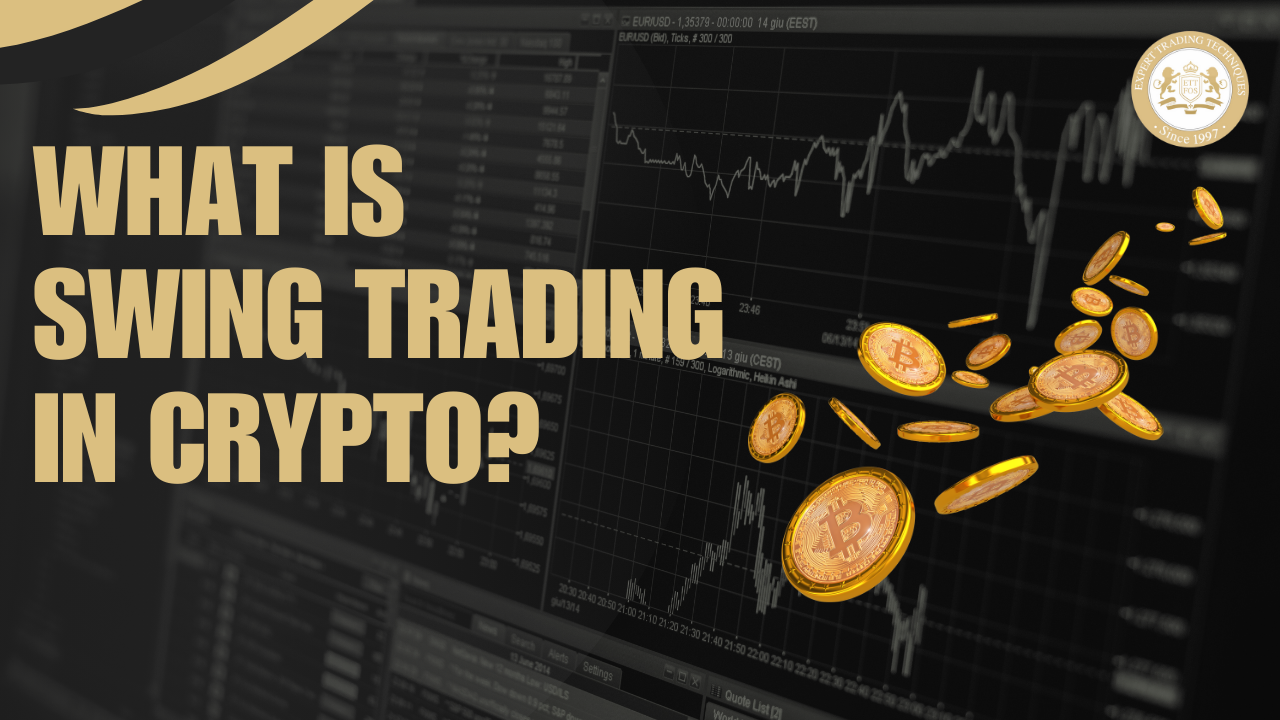
Imagine one day you wake up just to find that Bitcoin has surged 10% overnight. This kind of volatility is common in the cryptocurrency market, where dramatic price swings can happen in just a matter of hours. For many traders, this volatility isn’t just a risk, it’s an opportunity.
Swing trading in crypto is all about harnessing these price swings to make a profit. Unlike day trading, where you might buy and sell multiple times in a single day, swing trading involves holding onto a position for several days or weeks. This approach allows you to capture the market’s ups and downs without needing to watch the screen all day long.
Many traders in this industry have experienced that how swing trading can turn the unpredictable nature of crypto into a profitable strategy. In this article, I’ll walk you through the basics of swing trading in the cryptocurrency market. I’ll also tell you how to spot potential trades, the tools you need, and the techniques for managing risks. By the end, you’ll have a clear understanding of how swing trading works and how it might fit into your trading strategy.
Also Read: What Is Commodity Trading

Crypto swing trading is all about making the most of short-term price movements in the cryptocurrency market. Think of it as catching waves in the ocean. Just like surfers look for the perfect wave to ride, swing traders look for ideal moments to buy and sell cryptocurrencies to ride the waves of price swings.
Instead of trying to make money from tiny, quick price changes like day traders or holding on for the long haul like HODLers, swing traders aim to profit from the natural ups and downs of the market over a few days or weeks. It’s like positioning yourself to catch the biggest and most profitable waves before they break.
Imagine you notice Bitcoin’s price is climbing up steadily but seems to hit a small dip. A swing trader might buy during this dip, expecting the price to bounce back up. Once the price hits a higher point, they sell and lock in their profit.
The goal? To make gains from these fluctuations without getting caught up in the daily grind of constant trading. It’s a bit like having a well-timed strategy where you’re not rushing every day but rather setting yourself up to make the most of the market’s natural swings.
Also Read: What Is Gold ETF
Swing trading can be super rewarding, but it’s important to follow some basic rules to keep things on track. Here are five key rules to help you navigate the swings with confidence:
Also Read: Techniques to Manage Emotions in Forex Trading

Getting into swing trading is easier than you might think. Just you have to keep these things in mind:
First things first, learn the basics. Read up on swing trading strategies, market trends, and technical analysis. There’s a lot of free info online, and understanding these concepts will set you up for success. Think of it as getting the right tools before starting a project.
Pick a user-friendly trading platform that suits your needs. Look for one with good charting tools and low fees. Platforms like Binance or Coinbase Pro are popular choices. It’s like picking the right vehicle for your road trip, you need something reliable and comfortable.
Begin with a small amount of money that you can afford to lose. This way, you can get a feel for trading without risking too much money.
Write down your strategy, including how much you’ll risk per trade, your target profits, and how you’ll handle losses. A solid plan helps you stay focused and avoid impulsive decisions.
Demo accounts are same like rehearsing your performance before the final show. There are many platforms which offer demo accounts, where you can practice trading with virtual money. Use this to test your strategies and get comfortable with the platform before putting your real money on the line.
Keep an eye on market news and trends. The cryptocurrency market is always evolving, so staying informed helps you make better decisions.
Also Read: What Is Energy Trading
When considering swing trading in the cryptocurrency market, it’s essential to weigh its potential benefits and drawbacks to determine if it aligns with your trading goals and risk tolerance. To help you make an informed decision, I’ve created a detailed table highlighting the key advantages and disadvantages of swing trading.
| Aspect | Advantages | Disadvantages |
| Potential for High Returns | – Opportunity to capture short-to-medium-term price swings, potentially leading to significant gains. | – High returns can come with high risks; potential for significant losses if trades go against you. |
| Flexibility and Time Efficiency | – Allows for trading over several days or weeks, making it less time-intensive than day trading. | – Requires constant market monitoring and decision-making, which can be time-consuming. |
| Ability to Trade Different Market Conditions | – Can profit in both rising and falling markets through various strategies. | – Market volatility can lead to unpredictable outcomes and increased risk. |
| Less Stressful than Day Trading | – Typically involves fewer trades than day trading, reducing the need for constant attention. | – Requires careful timing and analysis to avoid missed opportunities or overtrading. |
| Opportunities for Diversification | – Can employ various strategies and diversify across multiple assets to manage risk. | – Diversification can lead to complexity in managing multiple trades and assets. |
| Lower Transaction Costs | – Fewer trades than day trading can lead to lower transaction fees and spreads. | – Long holding periods might incur higher costs with certain platforms or strategies. |
| Development of Trading Skills | – Provides a balanced approach for developing technical analysis skills and market understanding. | – Learning curve can be steep, with potential for mistakes and losses during the learning phase. |
| Flexibility in Strategy | – Allows for the use of various technical indicators and trading strategies to find the best fit. | – Complexity of strategies can lead to confusion and poor execution if not well understood. |
| Less Impact from Market Noise | – Can avoid some of the noise and fluctuations that affect short-term day trading. | – Longer holding periods might be impacted by sudden market news or events. |
Also Read: Psychological Traits of Successful Traders
Many people confuse swing trading with day trading, while both are far different from each other. I have created a table highlighting the key differences in trading style, commitment, and strategies, so that you can get clear distinction between these two.
| Aspect | Swing Trading | Day Trading |
| Trading Duration | Holds positions for several days to weeks. | Opens and closes positions within the same trading day. |
| Frequency of Trades | Fewer trades, typically a few trades per week. | High frequency, often executing dozens of trades daily. |
| Time Commitment | Moderate; requires regular market checks and analysis. | High; requires constant monitoring and quick decision-making throughout the day. |
| Market Analysis | Focuses on medium-term trends and technical indicators. | Emphasizes short-term price movements and market news. |
| Trade Duration | Trades last from several days to a few weeks. | Trades last from minutes to hours. |
| Risk Management | Requires careful planning and risk management over a longer period. | Immediate risk management with strict stop-loss orders. |
| Profit Potential | Potential for significant gains from medium-term price movements. | Potential for quick profits from small price fluctuations. |
| Stress Level | Moderate, involves less frequent trading and lower pressure. | High, involves fast decision-making and high pressure. |
| Transaction Costs | Lower due to fewer trades; may benefit from reduced fees. | Higher due to the large number of trades and frequent fees. |
| Capital Requirements | Lower, less frequent trading requires less capital for margin. | Higher, frequent trading requires substantial capital for margin and liquidity. |
| Skill Set Required | Requires understanding of medium-term trends and technical analysis. | Requires rapid decision-making skills and a deep understanding of short-term market movements. |
| Emotional Impact | Less intense; involves less daily stress and emotional swings. | High; can be emotionally taxing due to constant monitoring and rapid trades. |
| Market Conditions | Can be effective in both trending and sideways markets. | Typically thrives in volatile markets with clear trends. |
Also Read: Common Terminologies Used In Stock Market
As I told you earlier, swing trading in the crypto world is all about catching those perfect waves of price movement. Here are a few straightforward trading strategies to help you make the most of your trades. Let’s have a look:
This is like riding a wave that’s already rolling. Identify the direction of the market whether it’s moving up or down and trade in that direction. For example, if Bitcoin’s price is trending upwards, you buy when there’s a slight dip and sell when it peaks. It’s a simple strategy that leverages the momentum of the market.
Sometimes, markets can get a bit too excited or depressed. This strategy involves trading against the current trend, aiming to profit when the market corrects itself. For instance, if Ethereum has been rising sharply and seems overbought, you might sell, expecting a short-term drop before it continues its trend.
Breakouts occur when the price moves beyond a key support or resistance level. When you spot a breakout like Bitcoin breaking above a major resistance level, then you can jump in early to ride the new trend. This strategy aims to capture the strong price movements that follow these breakout points.
This strategy is all about patience. After a strong price movement, the market often takes a breather or “pullback.” You wait for these temporary dips in an uptrend or rallies in a downtrend to make your move. For example, if Litecoin has been rising steadily and takes a short dip, you buy during this pullback and sell when it resumes its uptrend.
Also Read: Best Forex Trading Strategy
Choosing the right coins for swing trading can make a big difference in your success. Let me help you so that you pick the best ones:
Look for coins with enough price movement to make swing trading worthwhile. Coins with moderate to high volatility, like Bitcoin and Ethereum, are often good picks because their prices swing more, giving you better trading opportunities.
Focus on coins that are showing clear trends. You want to trade coins that are moving in a predictable direction, whether it’s up or down. Tools like moving averages can help you spot these trends easily.
Coins with high trading volume are generally better for swing trading. High volume means there’s more activity and liquidity, making it easier to enter and exit trades without too much slippage. It’s like choosing a busy road over a quiet alley for smoother travel.
Stay updated on news and developments related to the coins you’re interested in. Positive news or strong community sentiment can drive price swings. For instance, if a coin is getting positive headlines or major partnerships, it might be worth a closer look.
Look at charts and use technical indicators to assess whether a coin is in a good spot for a swing trade. Indicators like RSI and MACD can give you clues about potential entry and exit points.
Also Read: The Benefits of Using Volume Profile in Your Trading Strategy

Figuring out if your swing trading strategy is doing its job involves a few key checks. Here’s how to tell if you’re on the right track:
Keep a close eye on your gains and losses. If your strategy is working, you should see more wins than losses over time. It’s like keeping score in a game like if you’re winning more often, your strategy is likely doing its job.
Regularly review your past trades to see if you’re following your plan and making improvements. If you’re consistently hitting your targets and avoiding mistakes, that’s a good sign. Think of it as reviewing game footage to improve your performance.
Measure how often your trades are successful compared to your total trades. A high hit rate means your strategy is hitting its mark. For example, if your strategy has a 70% success rate, it’s doing well.
Look at how much you’re risking compared to the rewards you’re getting. A good strategy should have a favorable risk-reward ratio, meaning the potential gains should outweigh the potential losses. It’s like ensuring you’re getting a good return on your investment of time and effort.
No strategy is perfect right away. If you’re seeing some positive results but not quite where you want to be, tweak and refine your approach. Learning from each trade helps you improve your strategy over time, just like adjusting your technique in sports.
Also Read: Lot Size in Forex Trading
To make the most of swing trading, you need to pay attention to when the market is most favorable. So, the best time to swing trade is when market volatility and market participation are high.
Crypto markets are open 24/7, but that doesn’t mean every hour is ideal for trading. Look for times when the market is most active, usually during major market overlaps like when the U.S. and European markets are both open. This is when you’ll see higher trading volumes and more price movement, making it easier to catch those swing opportunities.
Trading around major holidays or on weekends can be less predictable because market activity might slow down. If you’re looking for steady movements and reliable trends, it’s best to trade during regular business days when the market is fully active.
Some traders find that early morning or late evening hours offer good trading conditions. This is when markets might experience significant moves or adjustments, giving you a chance to enter or exit trades effectively.
Also Read: Mental Models for Trading
When diving into crypto swing trading, having the right tools and platforms can make all the difference. Here’s a rundown of what you need to get started:
Choose a reliable trading platform to execute your trades. Platforms like Binance, Coinbase Pro, and Kraken are popular because they offer a range of features, from advanced charting tools to high liquidity. Think of these platforms as your trading dashboard where all the action happens.
Good charting software is crucial for analyzing price movements and making informed decisions. Tools like TradingView and Coinigy provide detailed charts, indicators, and drawing tools to help you spot trends and patterns. It’s like having a high-tech map for navigating the market.
Stay updated with the latest market news and developments using news aggregators like CoinDesk or CryptoSlate. These platforms gather news from multiple sources and keep you in the loop with what’s happening in the crypto world. It’s like having a news feed tailored just for traders.
Use technical analysis tools to refine your strategies. Indicators like Moving Averages, RSI, and MACD are essential for spotting trends and potential entry or exit points. These tools help you analyze past price movements to predict future ones.
Keep track of your investments with portfolio tracking tools such as Blockfolio or Delta. These apps let you monitor your holdings, track performance, and manage your portfolio all in one place. It’s like having a personal assistant for your crypto assets.
Also Read: Recover Lost Money from Forex
Swing trading in crypto is all about making the most of short-term price changes. To do well, focus on using smart strategies and managing your risks. Always set stop-loss orders to protect yourself from big losses and follow a plan that suits your style. By focusing on effective strategies like trend following and breakout trading, and by managing risks through stop-loss orders and careful position sizing, you can position yourself for potential success. Understanding and applying these principles helps you navigate the market’s ups and downs with confidence.
Let’s step into the world of swing trading with ETTFOS! Our courses offer practical strategies and tools to help you succeed. Check out our ETTFOS Core Masterclass to get started. Begin your journey today and take your trading to the next level!
To get started with swing trading in crypto, begin by learning the basics of the market and trading strategies. Open an account on a reliable trading platform like Binance or Coinbase Pro. Start with a small amount of money and practice trading using demo accounts to build your skills without risking real funds.
Simple strategies like trend following and pullback trading are a good start for beginners. Trend following involves buying in an uptrend and selling in a downtrend, while pullback trading focuses on entering trades when the price temporarily dips during a strong trend. Both strategies help you capitalize on price movements with a clearer approach.
Managing risk involves setting stop-loss orders to limit potential losses and determining how much of your portfolio to risk on each trade. Use a risk-reward ratio to ensure that your potential gains outweigh your possible losses. Diversifying your investments can also help spread risk and reduce the impact of any single loss.
Essential tools for swing trading include a reliable trading platform with good charting features, technical analysis tools like Moving Averages and RSI, and news aggregators to stay updated on market developments. Portfolio trackers are also useful for managing and monitoring your investments efficiently.